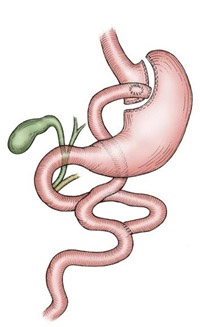For patients in the St. Louis and outlying regions
Laparoscopic and Open Surgery
The Roux-en-Y gastric bypass is a procedure frequently used to treat patients with morbid obesity. Morbid obesity is defined as being more than 100 pounds over ideal body weight. Candidates for surgery must have tried medical treatments for obesity and failed to maintain weight loss. The average patient is almost 200 pounds over ideal body weight and loses 140 pounds during the first year after surgery while also resolving many obesity-related diseases. The open version of this operation has been done for more than 30 years, and the laparoscopic version has been an increasingly common procedure over the past decade.
The Operation

In gastric bypass surgery, the surgeon uses surgical staples to divide the stomach and create a small upper pouch about the size of a golf ball. The intestine is then divided and brought up to the small stomach pouch, bypassing the lower part of the stomach.
General anesthesia is required for both open and laparoscopic bypass surgery. In open surgery, a traditional incision (12 to 24 inches) is made in the abdomen. The laparoscopic procedure uses six small incisions (each less than one-third of an inch) across the upper abdomen so the surgeon can insert laparoscopic instruments and stapling devices.
After gastric bypass surgery, the stomach will feel full more quickly than when it was its original size. In addition, bypassing part of the small intestine will lead to fewer calories being absorbed.
The Laparoscopic Approach
Laparoscopic surgery was developed to reduce the physical trauma associated with traditional surgical procedures. Factors considered in choosing whether to perform open or laparoscopic gastric bypass surgery include body mass index, a person’s body shape and previous surgeries. Your surgeon will determine whether laparoscopic surgery is the right procedure for you.
Typical benefits of laparoscopic surgery include:
- Reduced postoperative pain
- Earlier movement and walking
- Decreased hospital stay (two to three days with laparoscopic procedures, compared to four or five days with the open procedure)
- Quicker return to work and daily activities
- Nicer cosmetic healing with less chance of abdominal wall bulge from the typical incision
Reasons a Laparoscopic Approach Would Not Be Chosen
Some reasons a laparoscopic approach would not be chosen include:
- Patient weight of more than 450 pounds
- Previous stomach surgery
- Large amount of scar tissue
Risks
Generally, gastric bypass is a safe surgical procedure, which carries a 1 to 2 percent risk of death; however, about 20 percent of patients have major or minor postoperative complications.
Risks include:
- Leaking from the stomach or intestine
- Blood clots
- Heart attack
- Wound infection
- Blockage of the stomach or intestine
- Ulcer
- Hemorrhage (bleeding)
- Temporary decrease in lung function immediately after surgery
Post-Surgery Diet and Weight Loss
Most patients start on a liquid diet and begin walking the day after surgery. Generally, laparoscopic patients are ready to go home on the second or third day after surgery. If a traditional incision is required, expect the hospital stay to be four to five days.
In most people who have gastric bypass, the diet progresses from liquids to pureed foods to a regular diet over six weeks. Weight loss and resolution of diabetes and other obesity-related diseases such as sleep apnea, high blood pressure and arthritis occur gradually over the months after surgery. Patients lose an average of 70 percent of their excess body weight during the first year after surgery and then their weight stabilizes.
Surgeons who perform this procedure:
For more information, call 314-454-7224.
More information about bariatric surgery can be found at these web sites: